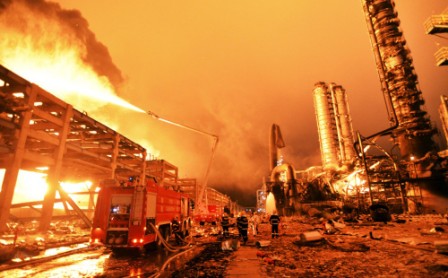Safety fears over Chinese chemical blasts
Tianjin
Residents living near the site of giant explosions in a Chinese port expressed fears for their safety Friday, after reports there could be hundreds of tonnes of dangerous chemicals at the site.
Officials in Tianjin, where the enormous blasts killed 50 people and injured more than 700, told a news conference they did not yet know what materials were at the hazardous goods storage facility where the explosions happened, or the cause of the blast.
But the Beijing News reported earlier that according to manufacturers, at least 700 tonnes of sodium cyanide were at the site, along with other substances, and the poisonous chemical had been detected in sewage samples in the area.
The report was no longer available on the newspaper's website Friday.
A team of 217 nuclear and biochemical materials specialists from the Chinese military began work at the site on Thursday, the official Xinhua news agency said.
Little activity was visible in the immediate area Friday, where devastation reigned and smoke still billowed from three different spots, although roads leading to it had been cleared of debris.
Some police wore no protective clothing, while others had full-face gas masks. Officers turned away residents who wanted to see the blast site, barring them from taking photos and telling them: "There's nothing to see here."
At a nearby office building, security guard Liu Zongguang, 50, wore a cheap surgical mask.
"I'm wearing this mask because I saw some police wearing them, but I also saw some without masks, I don't really know what to do.
"I'm really scared, but I don't even know what to be scared of, the government hasn't said anything, nothing about what we should do to keep our families safe from the chemicals."
The People's Daily, the official mouthpiece of China's ruling Communist Party, said that the facility's construction "clearly violated" safety rules.
Under Chinese regulations, warehouses stocking dangerous materials must be at least one kilometre (0.6 miles) away from surrounding public buildings and main roads, it said, but there were two residential compounds and several main roads within that distance.
Two hospitals, a convention centre, several residential compounds and a football pitch were also nearby, it said.
Approval for the facility was granted in 2013 while sales at one of the two closest residential compounds started the same year, suggesting it had "clearly" been built earlier.
"The warehouse should not have passed the environment assessment under normal circumstances," the paper quoted an unnamed environmental expert as saying.
Related Posts

